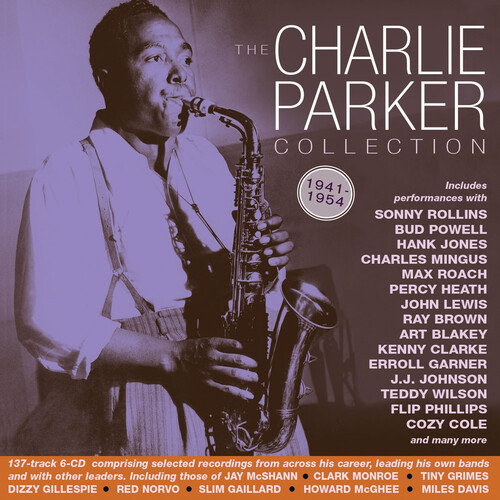 There are certain jazz artists that you need to know a lot about-Charlie (“Bird”) Parker is one of them
There are certain jazz artists that you need to know a lot about-Charlie (“Bird”) Parker is one of them
He didn’t do it single handedly, but he’s one of the main architects that turned jazz from a popular music that helped people dance to into an actual art form. This 6 disc 137 song set chronicles one of Bebop’s Mt Rushmore Members from his early days as a Kansas City sideman to the progenitor of a whole new musical world view, then to a high class creator of “jazz with strings”, Afro Cuban, and finally turning his Nike heat single style into mainstream jazz, eventually influencing every sax subsequent sax player in his wake, up to this very hour.
The set begins with Parker’s first “big” stint, with KC bandleader Jay McShann delivering a solo seeped in Midwestern swing on “Hootie Blues” before giving some R&B-toned work with Tiny Grimes’ Quintette on “Red Cross” and “Tiny’s Tempo”. From there, you have arguably the first bebop recordings, with Bird teaming with long time alter ego and trumpeter Dizzy Gillespie for world shaking pieces such as “Dizzy Atmosphere” and the humorous “Salt Peanuts” . He’s also seving as a sideman for the hipster Slim gaillard on “Dizzy Boogie” and sidelining with vibist Red Norvo on “Congo Blues”.
Parker leads his own quartets, quintets, sextets, sextets and “all stars” which include other faces on Mt. Rushmore such as Thelonious Monk, Miles Davis, Milt Jackson, Bud Powell, Art Blakey, Max Roach and JJ Johnson. Music was never the same after classics such as “A Night In Tunisia”, “Ornithology”, “Yardbird Suite” and “Moose The Mooche” with each solo setting a new high water mark for people to be inspired or to imitate. Even his infamous solos on “Lover Man” and “The Gypsy” are glorious in their desultory production.
At this stage in his musical career, Parker branches out into exotic Cuban music with wild orchestrations and solos during “NoNoise” and “Okiedoke”, but what really caught on was his brilliant idea of teaming his band with a small string section and producing “adult mood music” jazz on a gorgeous mix of art and sensuality on material such as “Laura”, “April In Paris”, “April In Paris” and “Summertime”. This is one of the highlights of 20th Century Music.
From there, Parker becomes one of the “elder statesmen” of the bebop scene, taking it to its limits, either with the blues on “Now’s the Time” or pop material such as “I Love Paris”. Because of his untimely and early death, Parker was never able to go another musical step, so instead of other artists like Miles Davis going into a more sophisticatedly harmonic sound, Monk going hard bop, or Dizzy expanding the Afro Cuban, Parker’s legacy is contained here serving as a pure legacy of the joys, triumphs and width of bebop, the foundation of modern jazz. A music version of Edward Gibbons.